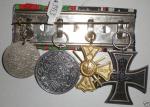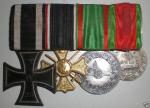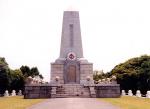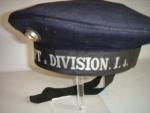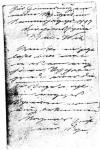-
Posts
1,175 -
Joined
-
Last visited
-
Days Won
8
Content Type
Profiles
Forums
Blogs
Gallery
Events
Store
Everything posted by demir
-
HELLO, NICKEL RAILWAY IS APP. 30.000, LIFE SAVING I HAVE NO DATA. BUT I THINK THE BAR IS MADE BY THE OWNER. BECAUSE THE RIBBONS OF THE OTTOMAN MEDALS ARE NOT ORIGINAL COLORS. RAILWAY RIBBON COLOR IS: GOLD- RED, SILVER- GREEN, NICKEL- RED AND LIFE SAVING RIBBON COLOR DEPENDS THE NUMBER OF BRAVERIES SHOWN: 1- GREEN 2- RED 3- WHITE AND 4 OR MORE TIMES ALL THREE COLORS. ALSO, THE DATES MAKE IT INTERESTING BECAUSE GERMAN MEDALS MUST HAVE BEEN GIVEN AT LEAST 6 YEARS LATER, BECAUSE THE IRON CROSS IS DATED 1914. SO either THE PERSON WHO HAD THIS BAR WORKED IN THE RAILWAYS AND LATER FOUGHT IN THE WWI or SOMEONE CREATED A scenario demir
-

Turkey 1937 Japanese Turkish Navy Ertugrul Frigate Disaster Medal
demir replied to Gunjinantiques's topic in Turkey
Commemoration Frigate Ertuğrul Memorial in Kushimoto, Japan Ironically, this accident created a general sympathy in Japan for Turkish people and led to the establishment of a strong basis for which friendship between Turkey and Japan was to later flourish.[8] In February 1891, a cemetery was established for the 150 sailors recovered dead at the calamity, and a memorial next to it was built near the lighthouse in the town of Kushimoto, Wakayama.[9] Emperor Hirohito visited the cemetery on 3 June 1929, which was extended the same year. Turkey renovated the monument in 1939. In 1974, a "Turkish Museum" was established, in which a scale model of the ship, photographs and statues of the sailors are on exhibition.[1] The event is being commemorated every five years on the day of the tragic accident in Kushimoto with the participation of high-level officials from Turkey and Japan.[8] In June 2008, Turkish president Abdullah Gül, visiting Japan officially, proceeded from Tokyo to Kushimoto to take part at a commemoration together with regional officials.[10] -

Turkey 1937 Japanese Turkish Navy Ertugrul Frigate Disaster Medal
demir replied to Gunjinantiques's topic in Turkey
HELLO, FRIGATE ERTUGRUL (tr.wikipedia.org/wiki/Ertuğrul_Fırkateyni) also pictures included BEST WISHES demir Ship Ertuğrul, ordered in 1854 by Ottoman Sultan Abdülâziz (reigned 1830-1876), was built in the Taşkızak Shipyard in Golden Horn, Istanbul and was launched on 19 October 1863 in presence of the sultan. She was named for Ertuğrul Gazi (1198–1281), the father of Osman I, founder of the Ottoman Empire. A three-mast wooden ship, she was 79 m (260 ft) long, 15.5 m (51 ft) wide and had a draft of 8 m (26 ft). The frigate sailed to Great Britain in 1864, where it had steam engines and state of the art machinery installed, including electrical lighting. On 18 February 1865, she left Portsmouth to return home with two other ships of the Ottoman Navy, Kosova and Hüdavendigâr, visiting some French and Spanish ports on the way. After arriving in Istanbul, she anchored awhile in the Bosporus in front of the Dolmabahçe Palace and later took part in the campaign against the Great Cretan Revolution in 1866.[3] Subsequently she was locked up in Golden Horn during the reign of Abdul Hamid II (1876-1909). Turkish Japanese relations In November 1878, the squadron Seiki of the Japanese Imperial Navy arrived in Istanbul en route to a training mission in Europe, and the envoy was received by Sultan Abdul Hamid II and honored with various medals.[4] Then, in 1881 the Emperor's relative Prince Kato Hito came to the court Yıldız Palace in an effort to conclude agreements relating to trade and wartime status.[5] Upon the visit of Prince Komatsu Akihito to İstanbul in October 1887 and the presentation of Japan's highest order, the Order of the Chrysanthemum, to the sultan, the government of the Ottoman Empire decided to send a ship on a goodwill voyage to Japan in return.[6] Appointment The Grand Vizier Mehmed Kamil Pasha the Cypriot sent a note on 14 February 1889 to the head of the navy, Bozcaadalı Hasan Hüsnü Pasha, asking the name and possible departure date of a battleship, which was suitable to sail to the seas of Indo-China and Japan in order to put the theoretical knowledge of Naval Academy graduates into practice. On 25 February 1889, Hasan Husnu Pasha informed that the frigate Ertuğrul was suitable for the assignment and could accomplish the preparations required within one week and set sail within one month. The real reason of the journey and its importance was revealed then by the Grand Vizier as a goodwill visit to Japan for the presentation of gifts and the highest decoration of the Ottoman Empire, 'Medal of High Honor', from the sultan to the Japanese Emperor.[7] Another aim of the voyage was to show flag on the Indian Ocean.[6] On 6 April 1889, the naval ministry appointed as commanding officer Captain Ali Osman Bey, the most appropriate officer due to his knowledge of several foreign languages and his skills in seamanship.[7] Voyage to Japan The ship, in service for 25 years, was overhauled shortly before the voyage, and most of the hull's wooden parts were renewed.[6] Ertuğrul, with 607 (disputed figure) sailors — including 57 officers — on board, was instructed to set sail from Istanbul on 14 July 1889, with Captain Ali Bey commanding. The initial route was designed to make various necessary stops on the way. The first stop was planned in Marmaris, and the next one in Port Said before the passage through the Suez Canal. Visits in Aden and Somalia would follow the stay in Port Jeddah. Considering the seasonal winds, the ship would stop by at Port Pondicherry and Calcutta in India. After staying in Port Akabod and Port Singapore, she would carry on to Malacca by way of the Strait of Malacca. Proceeding to the north, the ship would stop by in Port Saigon and then in some docks in China to arrive in Hong Kong. Port Amoy and Shanghai would be the last stops before reaching Japan. Finally, after a stay in Port Nagasaki, the ship would arrive her destination in Port Yokohama. The return was scheduled in October of the same year. The ship experienced some problems during her long journey. On 26 July 1889, she entered the Suez Canal and ran ashore in Great Bitter Lake, destroyed the stern post and lost the rudder. After repairs, Ertuğrul set sail again on 23 September. While sailing in western Indian Ocean, the ship took on water from the bow. The crew was unable to conduct the necessary repairs until they reached Singapore. Ertuğrul was repaired in Singapore and departed on 22 March 1890. After a ten-day stop in Saigon, she arrived in Yokohoma on 7 June 1890. The journey from Istanbul lasted around eleven months. Captain Ali Osman Bey was promoted to the rank of a commodore during the journey.[1] In Yokohama, Admiral Ali Osman Pasha and the officers were received by Emperor Meiji of Japan on 13 June 1890. The gifts and the medal sent by Sultan Abdul Hamid II were presented to their intended recipients. Ali Osman Pasha was honored with the First Class Order of the Rising Sun, and Skipper Ali Bey with the Third Class Order of the Rising Sun. Other navy officers were also decorated with medals. Subsequently, Turkish officers were received by the Empress. On 14 June 1890, young Prince Yoshihito Haru received the Turkish admiral. On the following days, many receptions, dinners and ceremonies took place. During her stay of three months in Japan, Ertuğrul frigate lost twelve crew members to epidemic. Accident On 15 September 1890 at noon, Ertuğrul set sail from Yokohama for Istanbul. The very good weather conditions at the departure changed the next day in the morning. A reverse wind began to blow, getting stronger towards evening. By nightfall, the wind came from below the bow so that the sails had to be folded. At the same time, violent waves in the rabid sea began beating against the ship, which, under severe trial, could hardly make headway. The 40 m (130 ft) high mizzen mast collapsed and caused severe damage by shaking from side to side and banging into the other (rigging) sails. While the storm continued gaining power, waves coming from the bow separated the deck boards from the front. Water broke through into the coal depots in the boiler room. In the next four days, the crew tried to repair the damage by remedying the sails and tightening the shrouds. They also continuously tried to empty the water with buckets out of the coal containers, which was the most serious danger, since the pumps were insufficient. Despite all the efforts, the ship's disintegration was imminent and the only option was seeking sanctuary in a nearby port. They headed to Kobe, within 10 miles (16 km) of the ship, in the gulf beyond the Kashinozaki Cape with Oshima Lighthouse. Seawater breaking through finally extinguished one of the furnaces in the engine room. Almost immobile without main sails and sufficient propulsion, and having only the wind and the waves behind, Ertuğrul drifted towards the dangerous rocks at the eastern coast of Oshima Island. As the crew tried just to stop the ship before the rocks by emergency anchoring, the ship hit the reefs and fell apart at the first impact around midnight on 18 September 1890. At the site of the accident, around 533 sailors, of whom fifty were officers including the commander Admiral Ali Osman Pasha, lost their lives. Only six officers and sixty-three sailors survived. Six of the survivors were uninjured, nine severely wounded and the others with only lightly injuries. After the rescue operation, two survivors were taken to Kobe by Japanese ships, another two by a Japanese battleship and sixty-five by German gunboats. All the sixty-nine survivors were transported back to Istanbul aboard Japanese corvettes Kongō and Hiei, leaving Shinagawa, Tokyo in October 1890. The sultan accepted the officers of the Japanese battleships on 5 January 1891 and expressed his appreciation for the relief operation by decorating them with medals[4] Commemoration Frigate Ertuğrul Memorial in Kushimoto, Japan Ironically, this accident created a general sympathy in Japan for Turkish people and led to the establishment of a strong basis for which friendship between Turkey and Japan was to later flourish.[8] In February 1891, a cemetery was established for the 150 sailors recovered dead at the calamity, and a memorial next to it was built near the lighthouse in the town of Kushimoto, Wakayama.[9] Emperor Hirohito visited the cemetery on 3 June 1929, which was extended the same year. Turkey renovated the monument in 1939. In 1974, a "Turkish Museum" was established, in which a scale model of the ship, photographs and statues of the sailors are on exhibition.[1] The event is being commemorated every five years on the day of the tragic accident in Kushimoto with the participation of high-level officials from Turkey and Japan.[8] In June 2008, Turkish president Abdullah Gül, visiting Japan officially, proceeded from Tokyo to Kushimoto to take part at a commemoration together with regional officials.[10] Salvaging the wreckage On 4 January 2007, a salvaging project with contributions from the Institute of Nautical Archaeology (INA) in Bodrum, Yapı Kredi Retirement Partnership and the Turkish Foundation of Nautical Archaeology was announced to find the wreckage of Ertuğrul and completely float her to the surface. It is intended to exhibit her in the museum next to the Ertuğrul Monument in Kushimoto. U.S. and Japanese nautical archaeologists and historians join the excavation team.[11] A team of well-known nautical archaeologists from Turkey, Spain and Japan under the leadership of Tufan Turanlı, director of INA, reached on January 28, 2008 the ammunition store section of the wreck in a dive within the second phase of the underwater excavation project. Three cannon balls, each 40 kg (88 lb), of the ship's Krupp naval guns, tens of bullets and pieces of naval mines were recovered and safely brought to the Port of Kushimoto, where explosive experts of local police, Japanese Army and Navy examined them. The artifacts were later taken to Ertuğrul Research Institute for conservation. Tufanlı recalled that two Winchester rifles recovered earlier are on exhibition in the museum.[12] -
Dear Dave, Thank you for the lovely introduction and the pictures of the IndependenceMedal. This is the picture of obverse side. The figures on this side are: OBVERSE The first Parliament Building in Ankara under the rays of the sun. These raysrepresent the victory and the foundation and birth of the Turkish Republic Ankara houses and mosque on both sides of the Parliament. Under parliament symbol of earth and sickle and scythe,anvil and hammer,palette and brush represents the new Republic' commintment to science,agriculture, industry and culture and shows her aim to unite with heworld. Oak leaves and clouds on both sides and 23 April 1336 (1920) (inaugurationdate of the Parliament)(1336 left). Under the clouds a peasant women leading anoxcart. (representing the independence war.) 23 April written in the oldscript. (Using Arabic letters)(This changed after the acceptence of the Latinalphabet in 1928) Under the oxcart clouds and rays continues from above and inhe middle a plumb, representing the foundation of the state. REVERSE: Under the moon and the crescent (Turkish flag) the map ofthe Republic. A star representing the new Capital Ankara and 7 rays emergingfrom it, reaching the borders, Edirne on the west and Kars on the right. Withinthe upper border of the moon, there are olive leaves for peace and in themiddle, the date 1 November 1922 (1 Teşrinisani 1338 - abolition date of thesultanate). This medal is to be worn on the right side, half under the collar. Best wishes and thanks again. demir :beer:
-
Hi, First Medal: Yurtta Sulh, Cihanda Sulh : Famous motto of Ataturk (Peace at Home, Peace in the World) I don't know why it is given, but it is made in the State Mint n Istanbul. best wishes Demir
-
Hi, Devlet Ovunc Madalyası: State Medal of Pride (To be proud of ...) demir
-
Please als beware of dominique.80 from istanbul
-
Dear Friends, Please be aware of medals sold by certain sellers in the known website. "dursen51" then " cinare2006 " from Germany is selling mainly Akka (d'acre) medal and a medallion of german,austria and ottoman rulers Now " moys-10 " from Germany is selling the same medals. I believe they are all same. Also in these days "abilge" is selling some Osmanie's from Australia, he also sells through Belgium. He also sells Mecidie orders but they are easy to understand becaus of the position of the stars on top the layer. 330345390999 330345593738 330345592667 330345596310 (imagine a red Osmanie) Best wishes
-
Hello, " moys-10 " from Germany is also selling same medals of above mentioned sellers. Artikelnummer: 160344141528 Also selling a TWM :Canakkale Madalyası Eiserner Halbmond 160344136828 best wishes demir
-
PICTURE 6 SOME PICTURES ABOUT WERFT DIVISION Sailors of the Werft Divisions were used to guard naval bases and as marine infantry on board ships. 1.An NCO's cap from the I. Werft Division. 2.The other side of the Werft Division cap 3.The inside of the Werft Division cap showing the owner's name (Esser), unit number and date (1916)
-
PICTURE 4 GOEBEN (YAVUZ) Along with the battlecruiser Goeben, the light cruiser Breslau served in the German Mediterranean Sea Division at the outbreak of World War I. On 15 August 1914, the Goeben and Breslau (along with their crews) were formally transferred into the Turkish Navy and renamed Yavuz Sultan Selim and Midilli respectively. On 20 January 1918, the Goeben?Yavuz Sultan Selim and the Breslau?Midilli sortied into the Aegean Sea to attack British troop transports. Shortly after taking part in the sinking of the British monitors Raglan and M 28 off Imbros, the Breslau?Midilli struck five mines and sank with the loss of 331 Turkish and German members of her crew. The surviving 162 crewmembers were rescued by a British destroyer and became prisoners of war. The Goeben?Yavuz Sultan Selim also struck multiple mines during the same action and was run aground on her return voyage. Although exposed to heavy air attacks, she was finally freed from the sandbank six days later.
-
Dear Friends, I bought a picture recently about the German Sailors under the command of Werft Division I.A.L (what I can read from the picture) served in one of the two war ships battle cruiser Goeben (later YAVUZ) , the light cruiser Breslau (later MIDILLI). Pictures will be shown below in other attachments.(because of the upload limit) If anybody can read the letter behind the photo, written in 1917 please translate it for me. I also included the some pictures about the Werft Division Thanks demir PICTURE 1 Sailors of the Werft Division I.A.L 1917
-
Dear Terry, Lovely certificate. You are lucky to find one like this. I am sorry that we couldn't meet this time but I am sure that we will get together next year either in Turkey or England. demir
-
Lovely bar. He also had TWM. demir
-
Hello, When you find the book for USD 100 in ebay buy it. It is a heavy book around 3 kg. So the S/H will be high. It is hard to find now. Don't forget it is only Turkish. If anybody is interested I can try to find in Ankara and inform the price. Best wishes demir
-
QUOTE (Ed_Haynes @ Mar 2 2009, 00:12 ) <{POST_SNAPBACK}> Very nice! Thanks, Demir (and Rick). More information on the Edhem Eldem book, please? Hello Ed, The book was published on the occasion of the exhibition named Iftihar and Imtiyaz (Valor and Privilege) Ottoman Order and Medals organized by Turkish ministry of Culture and Garanti Bank between 28.9.2004-26.12.2005. The name of the book is Iftihar ve Imtiyaz, Osmanlı nisan ve Madalyalar Tarihi by EDHEM ELDEM sold during the exhibition. price app. USD 80.00. 528 fine paper pages with a lot of pictures of the military personel wearing order and medals + all ottoman medals,orders,bars etc. Best wishes Demir
-
picture 4 book: Ottoman Medals and Orders Documented History by Metin Erureten 1. Canakkale (Gallipoli), 2. Caucasus best wishes Demir
-
picture 3: Book: Iftihar ve Imtiyaz, History of Ottoman Order and Medals by Mr. Edhem Eldem 1st bar: Caucasus, 2nd bar: Sakarya (Turkish Independence war) 3,4,5 bars : Romania (Collection: Isa Akbas)
-
picture 2: Book: Iftihar ve Imtiyaz, History of Ottoman Order and Medals by Mr. Edhem Eldem from left 3rd ribbon bar : Palestine (Collection: Isa Akbas)



